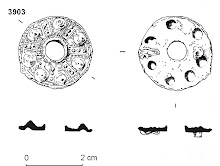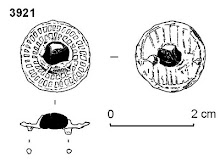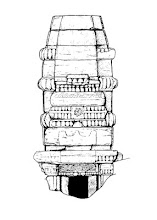Urban Archaeology has been recording and
researching the monument pro bono for Minchinhampton Local History Group
and Holy Trinity Minchinhampton. Most of the memorial is carved from
local Painswick Stone, but the effigy is in English Alabaster, a very
soft and beautiful stone that would have been carved in a specialist
workshop and shipped to the church for assembly by the local monumental
mason. There are traces of gilding on the effigy that suggest it may
have been partially painted.
As
the article says, it is a rare example of an effigial memorial to a
child at this time. Anne died aged under a month, but the effigy is of a
young child, not a newborn, why is not immediately clear but may be
that the family were imagining their daughter as she would have been,
rather than as an anonymous swaddled baby.
18th
century antiquarian Ralph Bigland tells us the memorial was originally
located on the north wall of the chancel and used to include the Baynham
coat of arms, when the chancel was demolished in 1842 the memorial was
moved and set up in the north transept. Painted numbers on the reverse
of each piece show that there were in fact two missing parts of the
memorial which were not re-erected. Possibly these were badly damaged so
not replaced, repairs to the memorial were crudely done -certainly not
by an experienced mason.
The memorial
has in fact already been moved and is set up in the church narthex
alongside an excellent collection of memorials. The memorial is being
'unveiled' this evening. Research is continuing into the memorial and
Anne's family and a full report will be published in due course.
The memorial is included in the new book on Minchinhampton church, available from the church or from Hobnob Press.
Thanks
to all at Minchinhampton Local History Group, Holy Trinity, and to Mark
Hancock and his team at Centreline Architectural Sculpture who carried
out the move.














